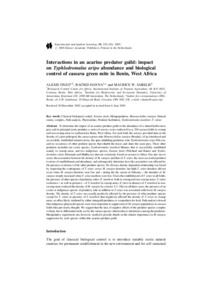| dc.contributor.author | Onzo, A. |
| dc.contributor.author | Hanna, R. |
| dc.contributor.author | Sabelis, M. |
| dc.date.accessioned | 2019-12-04T11:23:48Z |
| dc.date.available | 2019-12-04T11:23:48Z |
| dc.date.issued | 2003-11 |
| dc.identifier.citation | Onzo, A., Hanna, R. & Sabelis, M.W. (2003). Interactions in an acarine predator guild: impact on Typhlodromalus aripo abundance and biological control of cassava green mite in Benin, West Africa. Experimental & Applied Acarology, 31(3-4), 225-241. |
| dc.identifier.issn | 0168-8162 |
| dc.identifier.uri | https://hdl.handle.net/20.500.12478/4160 |
| dc.description.abstract | To determine the impact of an acarine predator guild on the abundance of a shared herbivorous prey and its principal exotic predator, a series of surveys were conducted in ca. 200 cassava fields in swamp and non-swamp areas in southwestern Benin, West Africa. For each field, the surveys provided data on the density of a pest arthropod, the cassava green mite Mononychellus tanajoa (Bondar), of an introduced and successfully established natural enemy, the apex-inhabiting predatory mite Typhlodromalus aripo DeLeon, and on occurrence of other predator species that inhabit the leaves and share the same prey. These other predators included one exotic species, Typhlodromalus manihoti Moraes, that is successfully established mainly in swamp areas, and two indigenous species, Euseius fustis (Pritchard and Baker) and Typhlodromalus saltus (Denmark and Matthysse), that are commonly found on cassava in Africa. Our aim was to assess the association between the density of M. tanajoa and that of T. aripo, the most successful predator in terms of establishment and abundance, and subsequently determine how this association was affected by the presence or absence of the other predator species. No obvious density-dependent relationship was found by inspecting the scattergrams of T. aripo versus M. tanajoa densities, but high T. aripo densities did not occur when M. tanajoa densities were low and - during the dry season in February - the densities of M. tanajoa steeply increased when T. aripo numbers were low. Given the establishment of T. aripo in all fields, the presence of other species of predatory mites (T. manihoti, both in swamp and non-swamp areas; T. saltus in absence - as well as presence - of T. manihoti in swamp areas; E. fustis in absence of T. manihoti in non-swamp areas) reduced the density of M. tanajoa by a factor 2–3. Thus in all these cases, the presence of an exotic or indigenous species of predatory mite in addition to T. aripo was associated with lower M. tanajoa density. The density of T. aripo was usually positively affected by the presence of other predator species except for T. saltus in presence of T. manihoti that negatively affected the density of T. aripo in swamp areas, an effect likely mediated by either intraguild predation or competition for food. Path analysis showed that indigenous phytoseiid species were more important in suppression of M. tanajoa populations in cassava fields than previously thought. We suggest that the lack of negative effects of the predator species complex is likely due to differential niche use by the various species which reduces interference among the predators. Manipulative experiments are, however, needed to provide details on the relative importance in M. tanajoa suppression by each species within this acarine predator guild. |
| dc.description.sponsorship | Danish International Development Agency |
| dc.description.sponsorship | International Fund for Agricultural Development |
| dc.description.sponsorship | Netherlands Organisation for Scientific Research |
| dc.language.iso | en |
| dc.subject | Biological Control |
| dc.subject | Mononychellus Tanajoa |
| dc.subject | Path Analysis |
| dc.subject | Phytoseiidae |
| dc.subject | Predators |
| dc.title | Interactions in an acarine predator guild: impact on Typhlodromalus aripo abundance and biological control of cassava green mite in Benin, West Africa |
| dc.type | Journal Article |
| dc.type | Journal Article |
| dc.description.version | Peer Review |
| cg.contributor.crp | Roots, Tubers and Bananas |
| cg.contributor.affiliation | International Institute of Tropical Agriculture |
| cg.contributor.affiliation | University of Amsterdam |
| cg.coverage.region | Africa |
| cg.coverage.region | West Africa |
| cg.coverage.country | Benin |
| cg.isijournal | ISI Journal |
| cg.authorship.types | CGIAR and advanced research institute |
| cg.iitasubject | Cassava |
| cg.iitasubject | Pests Of Plants |
| cg.accessibilitystatus | Limited Access |
| local.dspaceid | 99726 |
| cg.identifier.doi | https://doi.org/10.1023/B:APPA.0000010380.44408.05 |

